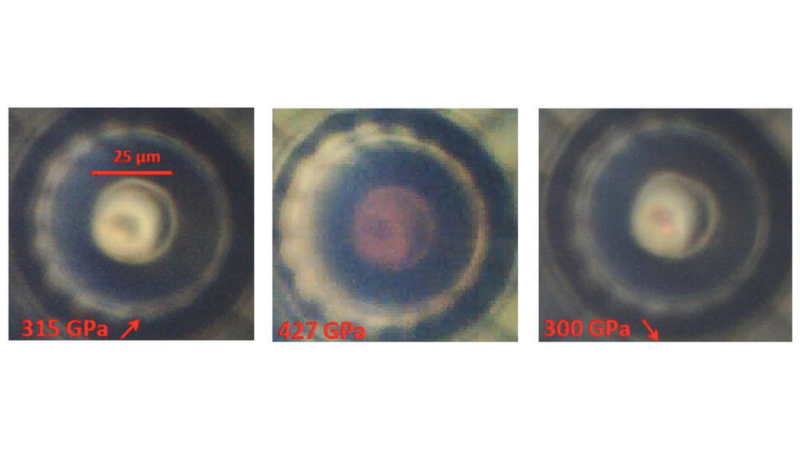Scientists Say They've Finally Made Metallic Hydrogen

A team of French scientists claim to have finally cracked the puzzle of metallic hydrogen. Their claim, published in scientific paper depository arXiv, which moderates papers but does not offer peer review, was met with intrigue and skepticism.
Hydrogen is easily found on Earth, the sun, and several planets in the solar system. It's the most abundant element in the universe. It is commonly known as a gas, but in 1935 physicists Hillard Bell Huntington and Eugene Wigner theorized that it could also be turned into a solid, metal state under extreme pressure. Wigner would later go on to solve another of the 20th century's great mysteries, a crucial member of the Manhattan Project team.
The potential for the substance is tremendous. It could, for example, be able to transfer electricity without the bothersome habit of heating up, potentially giving birth to a completely new form of superconductor. It could also potentially deepen understanding of the universe-some scientists believe that at the center of gas giants like Jupiter resides a core of metallic hydrogen.

There have been several claims of metallic hydrogen finds in recent years. In January 2017, Harvard physicists claimed to create the substance, calling it the "holy grail of high-pressure physics.” But by March of that year, their claims had fallen under serious scrutiny. Paul Loubeyre of the Atomic Energy Research Centre for Military Applications in France, called the 2017 study "much ado about nothing."
Now, Loubeyre is leading the French team making the claim of metallic hydrogen.
The group used what are known as diamond anvil cells (DACs), machines compromised to two diamonds to create tremendous pressure. The diamond tips of the DACs used by Loubeyre's team were toroidal, a new design developed in 2018 that allowed for greater high-pressure limits.
After placing a small amount of hydrogen into a toroidal DAC, the group further added pressure and began to analyze how the sample reacted to absorbed infrared radiation produced by what's known as the SOLEIL synchrotron, a particle accelerator that creates synchrotron radiation, a very powerful form of light.
At such tremendous pressures, researchers tell Gizmodo that quantum effects allow the electrons to flow through the sample as they would in a metal.
Without peer review, the same skepticism towards the 2017 study should be given towards the new work. Multiple questions, including if the substance created can be kept in a metallic state, remain. But the potential for discovery has experts excited:
So we have seen these claims before, back in 2017 for instance, when the PI of this paper was a leading skeptic. Do we now have reliable creation of metallic hydrogen? Nobel Prize stuff. More selfishly, hands on studies of giant planet interiors!! https://t.co/ra5QgefOX4
- James Jenkins (@ExoplanetJJ) June 21, 2019
Metallic hydrogen peeps out!
Loubeyre et al. just posted this work. Squeezing H at incredible pressures!https://t.co/x6HBbZ0bfK
Paper is still under review. In the mean time, they better book a flight to Stockholm.#materials #superconducting #hydrogen #NobelPrize #underpressure pic.twitter.com/pDz7Lw9Clf- Daimon (@Daimoners) June 21, 2019
There's ALOT of chat about this paper posted on @arxiv https://t.co/QYCVCkvXMd has metallic hydrogen finally been shown experimentally?
- Dr Helen 👩🏻🔬🏴🇦🇺 (@Helen_E_MC) June 21, 2019
Suppose we need to wait to see if this paper makes it through peer review.
- Dr Helen 👩🏻🔬🏴🇦🇺 (@Helen_E_MC) June 21, 2019
Source: Gizmodo
('You Might Also Like',)

